#The Millennials Kyoto
Explore tagged Tumblr posts
Note
yo. I wanna hear your personal gojohime headcanons or a married gojohime headcanons for fun! one of my hc is if gojohime is married with kids i feel utahime and gojo would sing disney songs to them.
Aight here goes my gjhm hcs!! (u might even catch them sometimes show up in my fics hehe)

They have movie nights together where their millennial asses routinely watch the entire saga of twilight and dunk on them
Also, they have collected the original soundtrack CDs for the entire saga (cuz both agreed that twilight ost actually slaps).
Gojo sometimes randomly spawns into Utahime's kyoto office to have lunch together and annoy/distract her from making her lesson plans LOL
It's confimed that Gojo is an only child and Utahime, being the opposite of Gojo, I headcanon that she grew up with LOTS of siblings and is the eldest :’))
I just recently started liking the HC that gjhm have known each other since childhood.
Gjhm focused in being parents/mentors to their students especially when working as a team. For a while, it's a running gag of tokyo-kyoto kids being against them ending up together LOL
Their marriage ceremony is modest as uta wanted and as much as gojo dont want to stfu about marrying utahime and wants it to be bombastic, they were able to have a small wedding.
It took A WHILE for them to honestly have kids cuz they knew how fucking cruel the jujutsu world is and these two wants to obviously provide safe environment for them. Also, they want to have the dedicated time to take care of them and not be constantly pulled from jujutsu missions (especially Gojo, cuz jeez that new official gojo booklet shows man works 24/7 💀💀).
Tbh, I dont have much hcs for gjhm parents, but I'd like to think gjhm's kids grew up in a very musical household cuz of their mom uta (so similar to your "singing disney songs" idea anon)
53 notes
·
View notes
Text
Stratford-Upon-Avon: June 26-29, 2024
As an English major and theater nerd, I pretty much had to visit Stratford-Upon-Avon, the hometown of William Shakespeare. Surprisingly, though, the highlights of this part of the trip for me weren't actually Shakespeare-related, though the Shakespeare tourism was really cool.
My first day there, I wandered around near my hotel and found a Ferris wheel to ride. I bought a ticket and got the whole ride to myself.

(Above: View from said Ferris wheel.)
After riding the Ferris wheel, I heard a four-piece band of preteens out busking in the plaza and absolutely slaying "Killing In the Name" by Rage Against the Machine.
I stayed to listen to their entire set, a set which seemed to be curated specifically to part Boomers through Millennials from their money. I wrote down all the songs I could remember at the end of the day:
"Smells Like Teen Spirit" by Nirvana
"Zombie" by The Cranberries
"Glory Box" by Portishead (?!?!?!)
"7 Nation Army" by the White Stripes
"These Boots Are Made for Walkin'" by Nancy Sinatra
"Sweet Home Alabama" by Leonard Skynyrd
I can't overstate how incredibly talented these kids were. I feel so blessed to have been able to catch their show. I tipped them £5 and asked them to promise never to stop making music.
Also: Look at the geese by the Ferris wheel and River Avon! (Fun fact: Avon means "river," so it's the "River River.") (Another fun fact: "Stratford-Upon-Avon" means "The Street Where You Cross the River.")

Another non-Shakespeare highlight was my visit was the MAD Museum, full of mechanical art, automata, and Rube Goldberg-style devices. It's fairly small, but I had an absolute blast wandering around and admiring everything.
But, of course, I also did Shakespeare things. My first full day in town, I bought a ticket for one of those open-top, hop-on/hop-off bus tours, which was recommended in the Rick Steves guide as being the best way to get out to see Anne Hathaway's (Shakespeare's wife's) childhood home, which is just a bit outside of town.
It was well worth the money and the trip. Her cottage is beautiful, and was in her family for several generations. You can see some sections that are fairly authentic to when she would've grown up there, and then there's an enormous garden, which includes a lot of really neat sculptures.

I also visited Shakespeare's grave, inside Holy Trinity Church. At the time Shakespeare lived, it was common practice to dig up people's graves about 20 years after they were buried, to make room for new bodies. Shakespeare was appalled by this, and not only arranged to be buried inside the church, he also wrote a curse to be placed on his resting place:
"Good friend for Jesus sake forbeare, To dig the dust enclosed here. Blessed be the man that spares these stones, And cursed be he that moves my bones."

While I was in town, I was hoping to see a performance of something by Shakespeare, but apparently I visited when there were no Shakespeare performances to be had. Instead, I visited the Royal Shakespeare Theatre and saw a production of Kyoto, a gripping political thriller based on a true story about the UN Climate Talks.
youtube
The protagonist(?) in the play is an American lawyer who served under Reagan, who after Reagan's second term was hired by OPEC to sabotage the UN Climate Talks. I never thought someone could make UN parliamentary procedure gripping, but I was wrong. I was on the edge of my seat for this play. If you ever get a chance to see it, do.
The theatre itself was beautiful, and almost completely in-the-round. I had a fantastic seat on the second level, only slightly off-center from the midpoint of the stage.

I don't have photos of them, but I also visited Shakespeare's New Place (which is mostly just a fabulous garden) and saw the exhibit for Shakespeare's Birthplace (the latter had a super long, slow line to get into the birthplace itself, and a lot of people in line were coughing, so I opted not to go in).
The most important Shakespeare-related thing I did during my visit, however, was having high tea at the Shakespaw Cat Cafe.



All the cats there are named after Shakespeare characters. Above, Horatio is trying to steal Hamlet's treats, and I'm holding Raven, an adorable kitten who blessed me by crawling into my lap and snoozing for a bit. 10/10, would drink tea and pet kitties again.
Things that made me giggle during this part of the trip:


2 notes
·
View notes
Note
What kind of students is everyone? Who’s likely to procrastinate vs get everything done as soon as assigned? Who tends to struggle vs just gets it? Who takes aesthetic notes and who chugs red bull 20 minutes before the deadline hits? I need everyone’s academic aesthetic 🤣
OKAY BUT WHY WAS I EVERY SINGLE ONE OF THOSE???????????
I DID ALL OF THOSE. I WAS PURE CHAOS.
Hi. I'm Kiko. I have a fucking Masters Degree. And I had really good grades. But I was a walking case of an undiagnosed Autistic, ADHD millennial woman. Therefore, I was WALKING CHAOS.
I still am. But now I'm diagnosed 🙃
Okay, but in all seriousness, hear me out: Gojo is the one who chugs a redbull twenty minutes before the deadline because he likes the taste of them and he's so fucking bored because he's so gosh dang smart that the assignment will put him to sleep if he doesn't have something to keep him awake. It's why he procrastinated. Because he finds most assignments dumb and pointless. It's effortless for him to grasp pretty much anything so he just doesn't care.
Rinko struggles to get some things, but she just needs to take the time to study it. She's incredibly fucking smart, but she's the "I need to pour over this for hours, but then I will literally never forget it" kind of smart. So her notes are well-organized and color-coded and she usually cleans them up so they're pretty, as well.
Nanami studies here and there, but then he fucking goes on a study marathon a few days before finals to make sure he passes. He always does, because he's also incredibly smart.
Geto is the most well-prepared at all times. But it makes sense because he's gonna be a lawyer.
Did this make any fucking sense? 🤔🤔
Shoko is at school in a different city, btw. She is childhood friends with Gojo and Geto, who are both from Tokyo. She stayed there for school while they went to Kyoto.
There will be a few instances where she visits!
Utahime is a high school teacher who moved to Okayama after she graduated. She was good friends with Rinko and Nanami when they were in school, but she's two years older than Rinko, so she's already done with school by the time our story between our two fluffy idiots 😊
AGAIN I FEEL LIKE I MADE NO SENSE???
14 notes
·
View notes
Text
It’s my 30th birthday! Normally I would do something like make a screenshot edit of Lapis and Peridot celebrating with me, commission art, or write a birthday-themed fic, but for the past couple months I’ve been traveling all over the world. Literally. Started in Norway in May and now for my birthday I’m in Kyoto, Japan. I have a few weeks left of traveling, consisting mostly of Japan, and then staying overnight in Los Angeles before returning home.
As I reflect on 30 years of existence, like many millennials I feel old, but logically we’re still quite young. In terms of what I want to do as a career I feel... a little accomplished, but admittedly nowhere near the expectations I had over a decade ago. I know it’s something I shouldn’t be ashamed of since we live in a crazy world with crazy societal expectations, and I’ll try my best not to let shame and guilt take over.
In terms of life experiences, particularly traveling, I feel very accomplished. When I was younger I didn’t exactly expect myself to be a world traveler, but after my first trip to Europe in 2011, and especially after studying abroad in Norway in 2015, I was hooked on traveling. I love exploring new places and getting a sense of what everyday life is like in those places. As my 3-month trip around the world nears an end I’ve already thought about what places I want to go to next (when I have the money of course).
11 notes
·
View notes
Text
april 29, 2024
checking in with a few updates!
1. life updates
i’m writing this from LAX, where i’m currently waiting for a red-eye back to nyc. why, you ask? well! i got married a few weeks ago, and my wife (!!) and i are just finishing up a honeymoon to japan :). the wedding was incredible — beautiful, filled with people we love, intentional at every step. it was truly a dream.
the honeymoon was also a dream. it was my first time in japan, and as someone of japanese descent (my mom is third-generation japanese-american), i was super eager to visit this magical place of my familial origin. we did and saw a lot — in tokyo, kyoto, nara, and hiroshima — but did a decent job balancing all the sightseeing with time for rest and relaxation. i’m sad the trip is over, but i’m happy to get back to normal life and hug my dog.




2. music updates
i’m happy to report that i’ve sent off the mixes for my upcoming EP to be mastered! i’ve been working on these tracks for months and months, and i’m very ready to share them with the world.
the theme of this project has always been captured by a mantra (of sorts) that i’ve had in mind since i started working on it: “songs for recovering cynics.” for me, these songs represent a renewed hope in life itself, a reconnection with nature and the wider world, and a feeling that even among the bad stuff, the universe offers something to believe in, something beautiful to hold near.
as a jaded millennial, this is honestly a pretty big shift in perspective for me. but, for many reasons, i feel supported enough in my life to open myself to hope ��� hope for me, for the people i love, for the world.
i’ll leave you on that positive note. hope you found a reason to smile extra hard today.
-kellyn
1 note
·
View note
Text


A test pack has been successfully performed. 🎉
It's now 5pm Saturday, and I check out of Kyoto early Monday morning. Two more nights at The Millennials Kyoto.
0 notes
Text
【京都住宿】The Millennials Kyoto,熱鬧河原町上的高科技時尚旅店,附入住注意事項

2017年夏天,京都最受矚目的旅店應該非The Millennials Kyoto莫屬,
中文翻譯是京都千禧一代膠囊旅館,
高科技加上時尚的設計感,實在很難不注意它! 而且地點還位於京都最熱鬧的河原町上!

The Millennials Kyoto的地點超級好,
隔壁是開到晚上十點的百元商店CANDO (京都很多店八九點就關門)
對面還有很好採買的業務超市,
附近的LOFT跟BAL都可以逛上半天,
然後一轉個彎就是新京極商店街跟錦市場!
不過從京都車站來還是要轉乘其他交通工具。
🚌做市巴士到河原町三条,步行約1分鐘

The Millennials Kyoto的入口是一個有沙發可以休息的小空間,
如果要 CHECK IN則需要搭電梯到樓上櫃臺。

下午三點可以開始辦理入住(退房為早上10:00)
有小排了一下隊,
櫃檯旁邊的大廳非常寬敞時髦~

入住的時候會先看一段介紹影片,
可以選擇日文或是英文,
然後之後會交給你一個POD,
進出房間就靠它了!
如果用丟要賠償3萬日幣,
所以一定要隨身攜帶好~

櫃檯旁邊有睡衣跟毛巾可以索取,
不過床位下的備品袋已經幫你準備好大小毛巾,
所以只需要拿睡衣就可以了。

這次入住女性專屬的樓層,
用這台POD感應才可以進出大門,
一進去完全沒有壅擠的感覺,
深色有質感的地毯與房間配色,
有種時髦的感覺~
對了,這邊的廁所與浴室都在同一個空間內,
我覺得非常方便~

每個人的空間是一個方塊,
有自己的床鋪,電燈還有全身鏡,
另外床的正下方則有空間可以放行李,
床鋪非常寬敞,還有附兩個枕頭。


可以看一下房間的介紹影片,
真的非常高科技感~
youtube
床的一旁附有個人專屬的插頭,數量非常足夠,
上面直接附有充電線,可以充隨身攜帶的POD,
控制電燈與床鋪位置直接用POD操作。

另外床頭可��遙控成豎直狀,很適合在房間內看影片~
The Millennials Kyoto還有一種房型,是附投影功能的, 如果訂這個房型,完全可以在半躺在房間看電影了!

雖然是膠囊旅館, 但因為附有屏幕,可以與外界隔離, 所以是蠻保有個人空間的~ 對了,因為屏幕拉到底會直接鎖上, 所以外出可以把行李放在床底下, 貴重東西還是需要隨身攜帶, 畢竟不是完全密閉的空間(屏幕左右是可以拉開的) 回來後,使用POD下方的鑰匙從外面解鎖,就可以把屏幕拉起!

床底下有放置一包備品袋, 備品袋內有大小毛巾跟一個小拉鍊包 小拉鍊包內有牙刷、梳子、衛生紙、耳塞與化妝棉。 小拉鍊包與裡面的東西是可以拿走的, 但大備品袋與毛巾則需要留下喔!


廁所跟浴室空間也很棒! 兩個空間分別獨立, 浴室是乾濕分離, 然後有附洗髮精、沐浴乳跟護髮乳~ 吹風機也一應俱全~



以上一切都非常美好, 不過這次入住我還是發生了小悲劇~ 起因是睡覺前我用POD調好鬧鐘, 想體驗POD鬧鐘響起,房內的電燈會自動亮起,床頭會豎起的科技感! 不過因為我睡前看電源還非常滿,所以我就沒有連結充電... 起床時還暗自稱讚這個床好好睡~ 結果一看手錶發現竟然已經超過退房時間! 鬧鐘因為POD沒電所以沒響, 然後房間一片漆黑也沒辦法開燈... 黑暗中我發現我床前的屏幕,竟然拉到底鎖住了... 明明睡前我把屏幕拉到跟床齊平的高度,並沒有鎖上, 不過可能是昨天調整床頭位置時,不小心拉扯到了(?至今還是個謎) 因為已經超過退房時間, 所以外面並沒有其他人, 就算想從屏幕左右邊的空間向外求救也無法, 最後不得已只好自己從屏幕鑽出來, 原本還擔心會把屏幕用壞,好險事後它恢復正常的形狀。 事後詢問其他入住過的朋友, 發現大家也有被鎖住的經驗, 像是屏幕往下拉太大力直接到底鎖住... 所以入住有兩個小細節要記住 1.記得晚上把POD充電,不然早上會一片黑 2.聽友人說事先把屏幕的鎖調整成不會直接鎖住的狀態比較安全(開鎖時再轉半圈) 這個我自己沒試過,不過至少屏幕不能拉太下面,以免不小心鎖上 最後我超過一個小時才CHECK OUT 多付了一千日圓~ 結果也無緣吃到早餐~ The Millennials Kyoto的廚房器具也非常時髦喔! 有一台七千台幣的BALMUDA蒸氣烤箱,
也有摩豆機跟手沖設備~
咖啡也是免費喝的!



撇開早上的短暫惡夢, The Millennials Kyoto不管是位置或是設計與舒適度都很棒 下次一個人去京都旅行,還會想入住~ 如果之後想來體驗高科技旅店, 上述兩點親身經驗注意事項,請大家務必記得喔! 🔍The Millennials Kyoto房價線上看
地址:京都市山崎町中京区235 官網
更多日本有趣事物,請加入日本多多粉絲團
(function(d, s, id) { var js, fjs = d.getElementsByTagName(s)[0]; if (d.getElementById(id)) return; js = d.createElement(s); js.id = id; js.src = "//connect.facebook.net/zh_TW/sdk.js#xfbml=1&version=v2.6&appId=357543425044"; fjs.parentNode.insertBefore(js, fjs); }(document, 'script', 'facebook-jssdk'));
ALOT in KYOTO
其他京都住宿心得

【京都住宿】2017新開幕,相鐵 fresa inn京都八条口 (相鉄フレッサイン 京都駅八条口)

【京都住宿】出站即達好方便,九条櫻花露台酒店Sakura Terrace🌸

【京都住宿】時尚旅店Hotel Anteroom Kyoto,便宜住宿選擇

【京都住宿】京都站前的平價住宿,Apa Hotel京都駅前與京都車站流水瀑布

【京都住宿】時尚旅店Hotel Anteroom Kyoto,期間限定蜷川實花概念房

【遊京都必備】京都美食地圖X不定時更新

遊京都必備X京都市集小筆記
2 notes
·
View notes
Text
Revolutionary Japanese Capsule Hotel "The Millennials" Brings Its Upscale Capsule Concept to Tokyo
Revolutionary Japanese Capsule Hotel “The Millennials” Brings Its Upscale Capsule Concept to Tokyo
IoT integration, futuristic style and design, coworking room, this lodge bring everyone’s beloved “quirky Japanese knowledge” to a full new degree. Push Launch – updated: Jan 25, 2018 TOKYO, JAPAN, January 25, 2018(Newswire.com) – Worldwide Agents has just introduced the Grand Opening of the second in its luxurious capsule lodge brand name ‘The Millennials’ for March 15th, 2018. Pursuing the…
View On WordPress
0 notes
Text
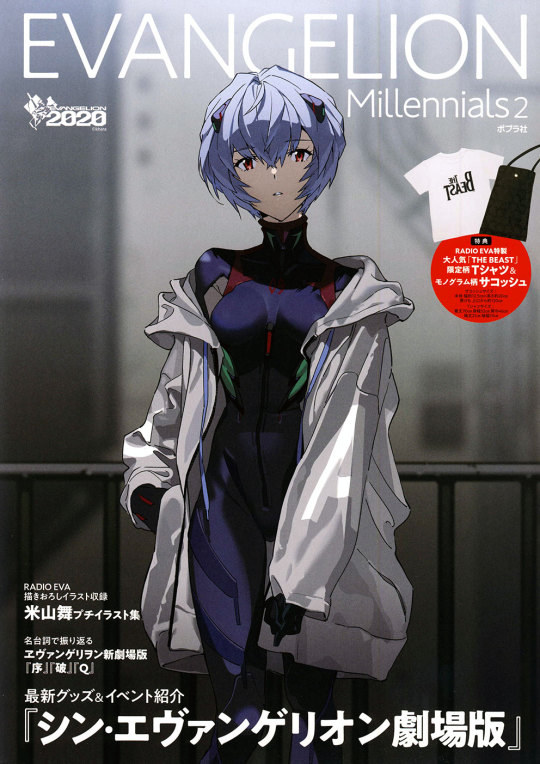
For my seventieth Evangelion book review, here is EVANGELION Millennials 2, published by Poplar Sha. This is a new mook (magazine-book hybrid) that came out just a few weeks ago, and as you can probably guess by the title, it is a sequel to the first EVANGELION Millennials (which I covered back in my sixty-sixth review). So this is another mook that is focused on fashion, which is why the cover art in the above image shows Tentative Name: Rei Ayanami wearing a hoodie over her plugsuit. Wow, she looks super stylish like that!
Of course, this publication has new looks for the other pilots as well. Check out this illustration of Asuka, Shinji, Rei, Kaworu, and Mari:
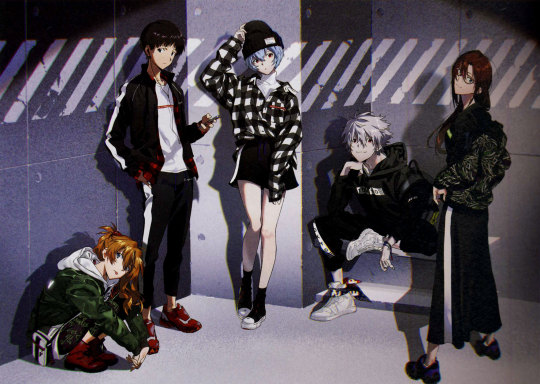
The pilots are wearing clothes from the RADIO EVA brand. Even the bandanna tied around Kaworu's right ankle is from RADIO EVA! By the way, this mook is not available in English or French (although there are a few little bits of English text here and there), but there are plenty of full color pictures. There are also some extra special goodies… more on that later. Keep reading for the rest of the book review, plus a few more pictures!
After the Table of Contents, this mook starts with a recap of the first three installments in the Evangelion New Theatrical Edition (AKA the “Rebuild” movies). This recap mainly consists of several pages of screenshots, accompanied by brief story descriptions and quotes from the movies. There are also a few trivia questions about the dialogue, plus some pics of the Eva pilots in their plugsuits.
The next section is the MAI YONEYAMA Drawn Illustration Collection, which showcases art that Mai Yoneyama has done for the RADIO EVA clothing brand, including the first two images shown in this review. And yes, the cute cover picture of Asuka and Shinji from the first EVANGELION Millennials is also in here!
This is followed by the EVANGELION GOODS 2020 section, which starts with a catalog of new stuff from RADIO EVA. As I explained in my review of the first EVANGELION Millennials, the RADIO EVA brand specializes in everyday wear, and many of their garments tend to reference Evangelion in a subtle way. For example, here is a dress that has flowers on one arm, with the Spear of Longinus embroidered among the flowers:

Usually I find that RADIO EVA's clothes are a bit too plain for my tastes, however I have to admit that dress is kind of cute. Good job, RADIO EVA!
For those who don't need subtlety and would rather express their love for Evangelion in a more overt way, RADIO EVA has a few things for that as well. For example, one of the items shown below is a tote bag that has a Mai Yoneyama illustration of the Eva pilots:
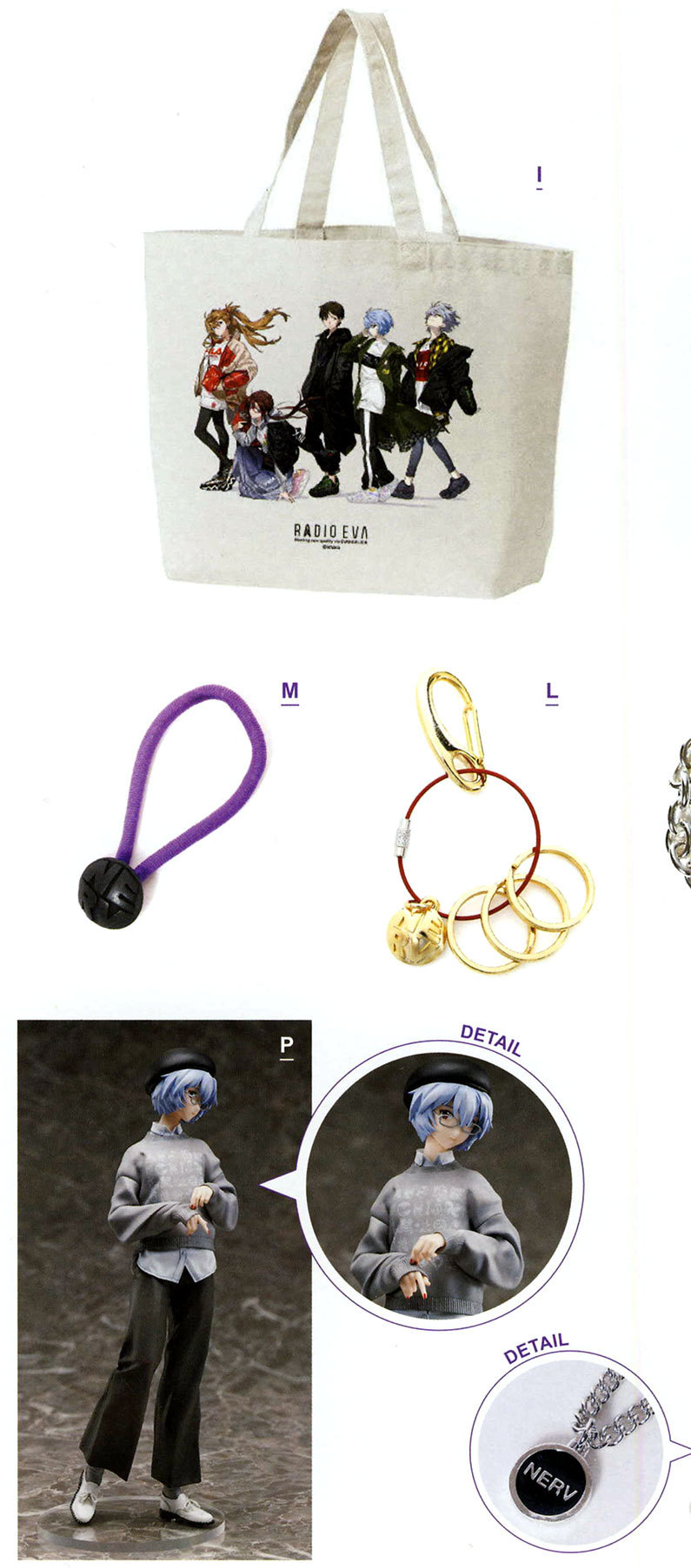
In the above image, the two items underneath the tote bag are subtle ones again. The first is a simple purple hair tie that says "NERV" (the purple color is supposed to represent Evangelion Unit-01), and the other is a red key ring (the color represents Asuka). Oh, and for those who prefer more character merchandise, at the bottom of that page is a figurine of Rei wearing RADIO EVA clothes.
Moving on, the next part of this mook is a catalog of some items from the Evangelion Store, including a mug and a T-shirt bearing the name of the next movie, Evangelion: 3.0 + 1.0 Thrice Upon a Time. After that, there is the OFFICIAL SHOP GUIDE section with pictures and info about various Evangelion shops in Japan. The stores are described in both Japanese and English, to make things easier for tourists... once it's safe to travel again, I guess. Sigh.
Next is the EVANGELION NEWS section, which covers some Eva-related merchandise, events, and exhibits. For example, one of the exhibits is a huge Evangelion Unit-01 in a pool of LCL, located in Kyoto. This Eva is so big that you can pose for a photo standing in the palm of her hand!
After the NEWS, there is a page promoting the Eva Extra mobile app, and then an advertisement for the Evangelion Battlefields mobile game. Here is the Evangelion Battlefields ad:

And finally, on the back cover of the mook, you can see poster art for the upcoming movie Evangelion: 3.0 + 1.0 Thrice Upon a Time. Yay! Sure, you've probably seen this image online already, but it's nice to actually own a physical copy! The picture shows Shinji standing on train tracks. Here it is:
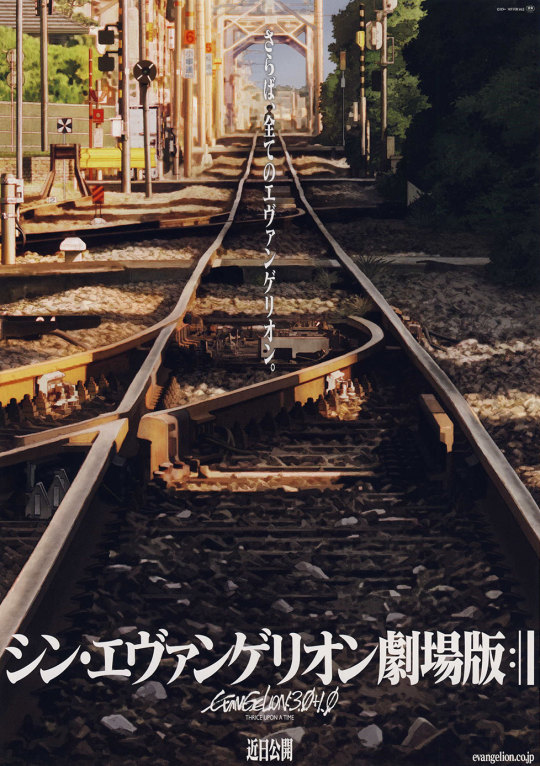
Yes, Shinji is there. He's standing in the distance, so he's very tiny in that picture. As for the film's release date, as you've most likely heard by now the movie was originally supposed to come out a few months ago (June 2020), but unfortunately it had to be delayed due to the COVID-19 pandemic. So the Japanese text at the bottom of the poster simply says "Kinjitsu Koukai" (Coming Soon). Sorry, folks. I know that's disappointing for many people, however it's understandable that safety should come first. Until then, I hope you all stay healthy and safe, so when the movie does come out we can get excited together! (EDIT, March 2021: The movie's new release date is March 8, 2021!)
Anyway, that's it for the mook itself, which is only 35 pages long. But wait, we’re not done yet! As I mentioned before, some extra special goodies are included. The first item is a white T-shirt that says "The Beast", courtesy of RADIO EVA:

If you're wondering why "The Beast" is written backwards, it's because of Mari's words "Invert mode. Backdoor code... 'The Beast'!". So the designer was inspired by the words invert and back, get it? Well, that and I'm pretty sure the font is a reference to The Beatles. I would make a joke about playing the Evangelion movies backwards to listen for hidden messages, except that actually works in the Evangelion 2.0 movie, during the scene when the Dummy System is activated inside Unit-01! Seriously, it's creepy.
Anyway, getting back to the T-shirt, it's one size only, but of course people come in different shapes and sizes. So in case you're concerned about the fit, I have translated the shirt's measurements as stated in the mook...
Length: approximately 70 cm
Width: approximately 52 cm
Shoulder Width: approximately 46 cm
Sleeve Length: approximately 21 cm
Sleeve Width: approximately 19 cm
I hope that helps! Moving on, the second bonus item is a RADIO EVA sacoche (pouch) with a cross-body strap. It can carry small items, such as a wallet and/or mobile phone. Check it out:
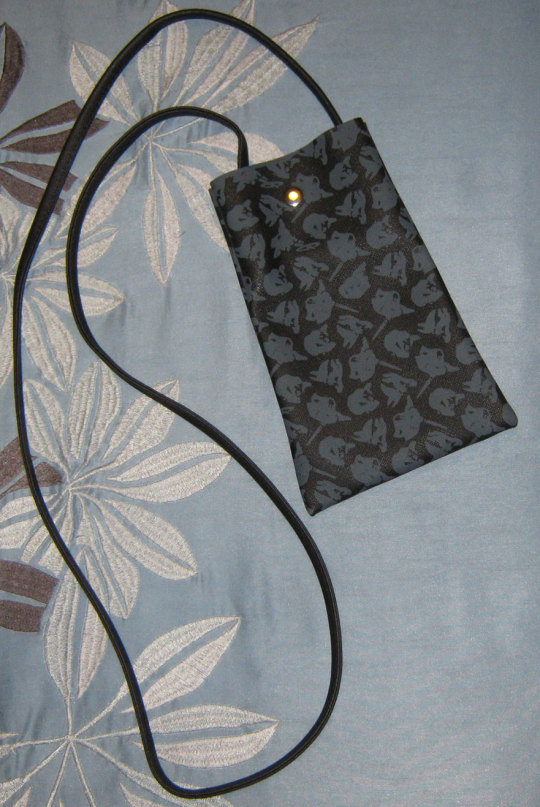
In case it's not clear in the above photo, the pattern on the sacoche consists of Evangelion heads. Here's a closer look at the pattern, so you can see it better:
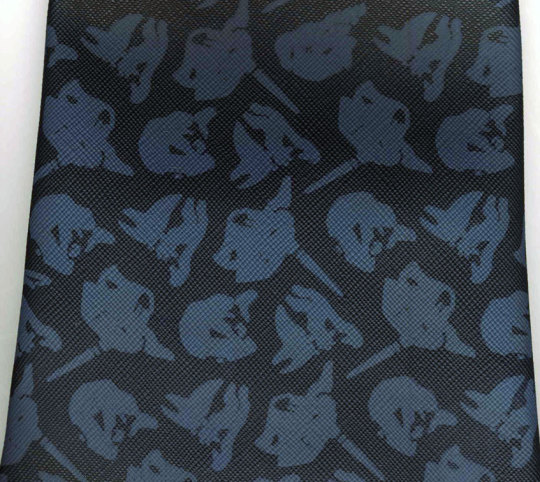
Overall, I think the best thing about EVANGELION Millennials 2 is Mai Yoneyama's illustrations. She has a good eye for detail, and I think she draws some great poses as well. However, most of RADIO EVA's clothes aren't really to my taste, so when it comes to fashion-related publications I prefer Mode EVANGELION and Mode EVANGELION2. That's just my personal opinion, though. If you love RADIO EVA, you'll probably find this mook a lot more interesting than I did. And that's cool! There are plenty of brands that make garments inspired by Evangelion, so it's nice that they cater to different preferences.
So if this mook (or the included goodies!) looks interesting to you, then please support the artists by purchasing it if you can! Check if your favorite source for buying Japanese books has it, and if not then ask them if they can order it for you. ^_^
Well, that’s it for my seventieth Evangelion book review. I have plenty more Evangelion books to discuss, so keep checking my blog for new reviews!
#Evangelion#Asuka Langley Shikinami#Shinji Ikari#Kaworu Nagisa#Rei Ayanami#Tentative Name: Rei Ayanami#Mari Illustrious Makinami#Spear of Longinus#Evangelion Unit 01#Evangelion Unit 00#Evangelion Unit 02#book review
184 notes
·
View notes
Photo





Working, resting and playing at The Millennials shared work space and ‘pod’ hotel in Kyoto
Read the full article: https://www.city-cost.com/blogs/City-Cost/GQrZw-living_food_kyoto
1 note
·
View note
Text
BECAUSE I’M NOT POPULAR, I’LL READ WATAMOTE: CHAPTER #163
Ah, summer. The season of no school, bright skies, pools, barbeques, and brief teenage romance.
Okay, so it’s not quite summer vacation yet. But nonetheless, the new season gives way for all sorts of fun shenanigans. None of it ever really enters “drama” territory (as dramatic as this series can be, that is), but as Tomoko’s last year of high school nears the halfway point, we discover that there’s still quite a bit we don’t know about our cast of knuckleheads.
Chapter 163: Because I’m Not Popular, It’s Summer

I think it can be inferred that Tomoko is not a morning person, is she?

I think it can also be inferred that the once-aspiring NEET Tomoko is not a fan of hot weather. Better soak up that Vitamin D, girl.

Parasol Lady Asuka would like to battle!

Are parasols more prominent in Eastern culture? They’re not too terribly common where I’m from, but I imagine that may be a result of Japan having more of an aversion towards anything that would result in darker skin. Though I can also see it as a sort of fashion opportunity as well.

I believe those were umbrellas you used, Tomoko. But semantics aside, It’s pretty neat to see that Tomoko has finally reached that stage in her life where she can recognize her cringy chuunibyou phase. Long live those days of failing miserably at being a cool anime character.

Remember when Tomoko used to slut-shame the girls in her class? I detect a hint of hypocrisy there...
Gyaru!Asuka has already exploded on the imageboards, I guarantee it.

A part of me wonders why Tomoko grouped Kii-chan and Yuri specifically. They don’t have similar personalities or anything, but I see two possible reasons for it. One, Kii-chan and Yuri both got that mild-mannered, “exotic” look going on. But also, it may who Tomoko subconsciously believes she’ll see the most of over the summer.

We’ll, I mean...yeah. They would. It probably doesn’t help that Tomoko, with her lion’s mane, gives the impression of someone too physically active to care much about grooming. But as much as Tomoko derides the possibility of looking like a “sweaty day laborer”, I can’t deny that it’s not a bad look on her.
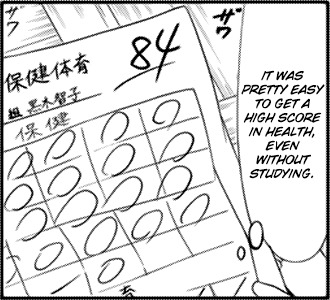
The reason for that should be dead obvious by now.

The thing that amuses me is that Tomoko had no basis to start insinuating that Yuri’s a pervert. She just did, and has latched on to the idea ever since. While no doubt annoying for Yuri (even if it’s true), it’s kind of sweet if you see it as Tomoko wanting to have a shared interest with her.
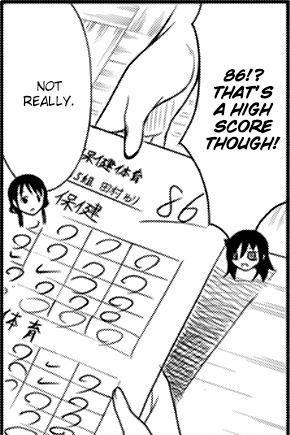
I’m sure that compared to your freckled, “crazy lesbo” best friend, it isn’t.
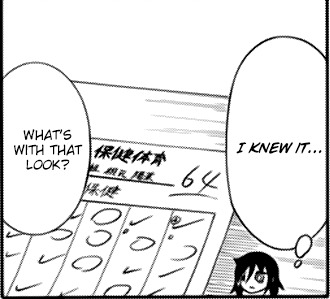
It’s funny how Nemo used to give off an air of someone who’s sexually acknowledgeable (at least to me) by virtue of being semi-popular. Now that we know’s she’s relatively pure, Tomoko will never let her live it down.
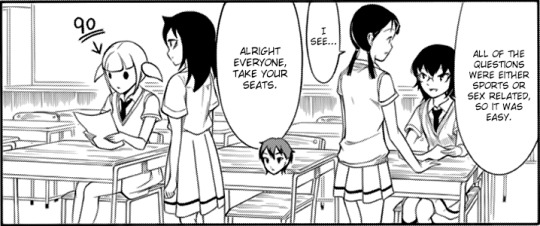
Komiyama really is the most two-dimensional character in the series. And you know what?
It works.

In the education industry, we call it the “Perv Curve”.

Komiyama: Self-explanatory.
Hatsushiba: Anatomically-correct BDSM art must have originated from somewhere.
Katou: Yet even more evidence for the almost-openly perverted girl who casually says “vagina”.
Mako: ...wait, what?
I’m so used to perfect scores being a badge of honor in Japanese media that it through me for a loop to see it suggested as anything else. Perhaps it’s an issue similar to Home Ec in that it’s not seen as educationally significant and only those really invested in the subject would master it. Either way, how lewd.

Going back to Mako, I am genuinely shocked. Could Yuri’s oh-so-sweet bestie actually have a dirty side? Just when you think you know a gal! Naturally, she has just enough to shame to be embarrassed when its brought up, and I’m not ready to call out Mako as a pervert just yet. At least she has Yoshida to pat her on the back (ironic given the delinquent is now officially the purest one of the Kyoto Group).

My Pokémon-obsessed mind can only see them as the Haramaku Elite Four, which, given the segment’s title, is highly unoriginal of me.
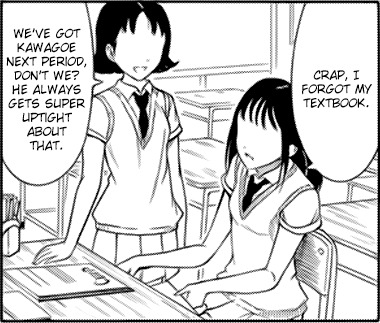
I’m 97% sure that Kawagoe’s that old geezer teacher we saw during Tomoko’s suspension. We even got that “strict about textbooks” continuity from way back when Tomoko forgot hers.

All signs point to Minami’s-Faceless-“Friend”-#1 recognizing someone, most likely Yuri, during this little intersection. Curse you, Nico Tanigawa and your wonderful vagueness.

Nope. It’s not gonna work. Nuh-uh. Absolutely not. You aren’t going to make me feel sympathetic for Minami.
...
...
drat.

All that speculation has finally paid off cause we now have confirmation that Minami did(does?) in fact backbite Tomoko and Yuri. Thank goodness for Tomoko’s mental health that she never knew. But Minami’s got some nerve teasing Yuri when she’s actively Mako’s friend. Even more disturbing if Mako doesn’t realize it...
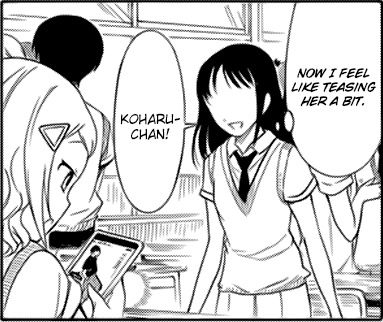
Between that tiny smile in the last panel and her wanting to tease, it’s pretty much certain that Minami’s-Faceless-“Friend”-#1 is not a pleasant person.
Birds of the same feather truly do flock together.
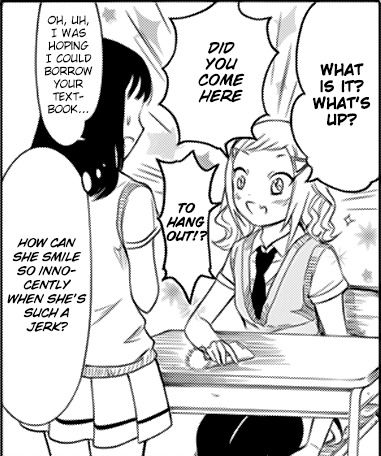
Okay, I cracked. Minami’s too adorable (and pitiful) right here.
I find it telling that even Minami’s “friends” know she’s a jerk. But if what goes around comes around, then Minami’s-Faceless-“Friend”-#1 might not realize she’s a jerk, too. Are most terrible people aware of their own terribleness?
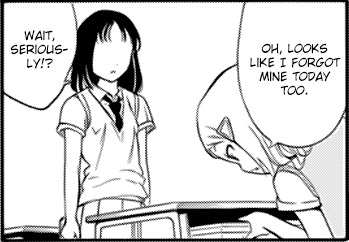
I don’t want to correlate jerkiness with irresponsibility but...here we are.

Man, that’s playing dirty. Suzuki is more than likely not that close to Minami, but any decent person wouldn’t just outright say “no” to a request like that. Of course, playing up her own supposed likeability through other’s basic kindness is Minami’s M.O.

In manga and anime, that sort of haughtiness from cute, snaggletoothed girls is adorable in that “sigh, there she goes again” way.
In reality, it’s just annoying as shit.

At first glance, Kayo’s just making an off-handed question, but my nit-picking mind says otherwise. I’m not sure how insistently heterosexual/romantic Japanese culture is towards male-female relationships, but would most teens show interest in a friend’s opposite gendered sibling? If say, Miyazaki had a little brother, would Kayo even ask Ucchi a question like that?
My theory is that Kayo is subtly trying to ascertain Ucchi’s sexuality. If the idea of Ucchi being gay for Tomoko is already planted in her head, then Kayo is using Tomoki as a “male version” for comparison. Ucchi’s already admitted to the Kuroki siblings being physically similar, so supposedly if she feels nothing towards Tomoki, then it’s Tomoko’s “femaleness” that attracts her.

This wouldn’t even be half as funny if Ucchi didn’t have an emoji face.
If only Komiyama could see this now...

Or, you know what? Maybe gender is irrelevant and Ucchi just has an indiscriminate gross fetish.

Nemo’s ultra-realistic thoughts behind her cheery demeanor are always welcome.

For all those times that Tomoko pokes fun at Nemo for wanting to live out a slice-of-life school anime, she’s not exactly innocent either. More and more we see Tomoko trying to invoke those cliche moments, usually with little fear. It’s a rather far cry from when she’d try to pull anime tropes as a means to an end. Now she tries them out just for the sake of having fun, which is much more endearing.

In this particular trope, however, normally you’d have a guy and girl stuck inside, where they’d ultimately become more attracted to each other through the suspension bridge effect.
Of course, that’s assuming the boy and girl aren’t already together. If they are, then storage rooms are usually used as a hiding place to make out, but that obviously would never hap–
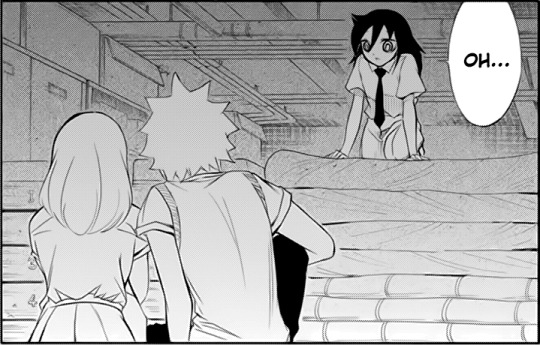
Oh.

FUCK.
If memory serves, this is the same couple who were flirting(?) back in the head patting chapter. A whole lot must of went down since then, eh?

Murphy’s Law.

It’s been quite a long time since we’ve had one of Tomoko’s infamous freakouts. And they say this series lost its roots.
A part of me wants to think that Nemo hears Tomoko but is pretending not to just to screw with her, but I don’t think she’d be that cruel. Even if it would be hilarious.

Just how far is your “it”, Tomoko. Making out? Groping? HANDHOLDING!?
What am I saying–she’s totally thinking sex.

It’s interesting to note that Tomoko just assumes that Yuri and Mako have never had a boyfriend. Sure, it may be implied given we’ve never seen them have this discussion before (that we know of), but it’s still pretty presumptuous on Tomoko’s part. My only reasoning is that Tomoko is trying to ally themselves over supposed “undesirability” like many self-deprecating friends do.
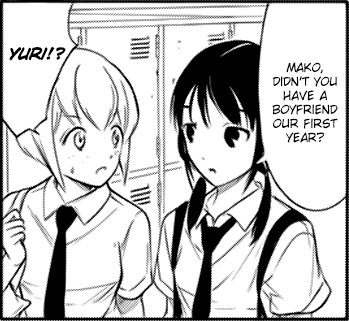
First off, I am not at all surprised given Mako’s personality.
What does surprise me is how totally betrayed Mako sounds. I can only assume that it’s a part of Mako’s past that she’d rather not reveal. While I don’t think Yuri meant any harm bringing it up, that kind of miscommunication goes to show that even though they’re best friends, Yuri and Mako don’t always see eye to eye.

Sounds like dating to me. Or rather, sounds like dating between high schoolers. At the risk of sounding like an old-ass millennial, dating between high schoolers rarely last, despite what shoujo manga suggests. Casual dating is exactly that–casual. They’re attracted to the novelty of dating, but once that initial thrill wears off, cue the breakup.
Side note, I just realized that Yuri loosens up her tie. I love small details like that.
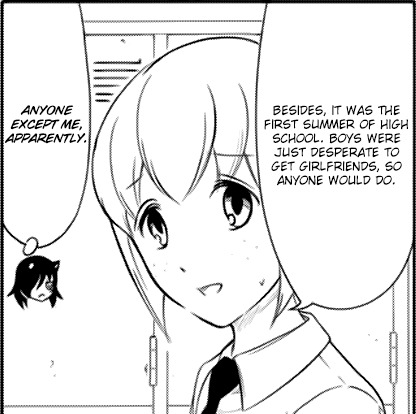
Perhaps I’m reading too much into it, but Mako seems to be suggesting that girls, on the other hand, aren’t as desperate to get boyfriends. While that isn’t necessarily true, I do see that answer as mostly a convenient excuse for Mako, who may simply just not want to be in a relationship right now.
I can see the “Mako is straight/Mako is lesbian(for Yoshida)” War right now...

Boy, it’s been a while since Tomoko has contemplated her own popularity, let alone try to be more popular. I guess it goes to show that even though Tomoko is more or less satisfied with her current status, she still sees herself below the bar of what constitutes “popular”. She does perpetuate feminine “purity” as an indicator of her societal value, but I’ll let it be–reality is not so kind, after all.
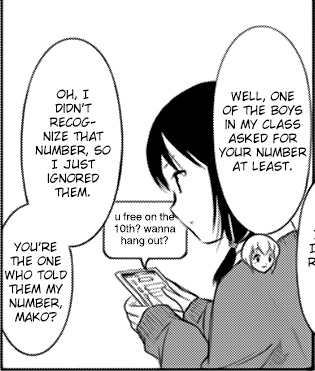
One of the more prominent questions that Yuri’s fanboys have is “How come someone as pretty as Yuri isn’t more popular with the boys?”
Well, there you go.
In terms of looks, I never thought Yuri was that unattractive in-universe. She’s in that small niche of “plain and generic, but just cute enough that fans feel they could feasibly ask out a girl like her in real life”. So while it's reasonable to think that at least one person would show interest in her, it's Yuri’s personality that ends up putting them off. She probably isn’t ready to commit to the effort of dating and being someone’s girlfriend. nor does Yuri seem that interested to begin with if her texting habits are anything to go by.

I can’t for the life of me remember the name for it, but I believe that there’s this belief in Japan that says everybody (mostly boys) has that brief period in their life where they’re suddenly attractive and people want to date them. I imagine that Tomoko may actually reach that time in life sooner than she thinks.
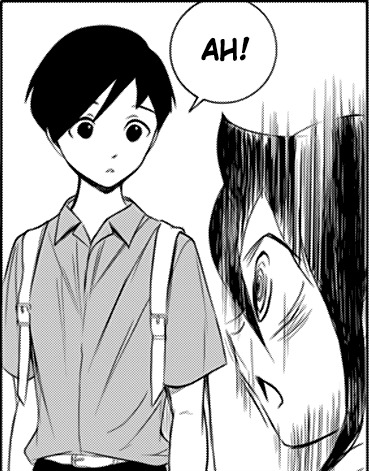
PTSD TRIGGERED!! For the readers, I mean.
For real, though. What a comeback. Who would have thought that Kosaka, that guy who was introduced in Chapter FIVE would make his grand return? Normally, making a reappearance this late in the game would feel like an asspull, but it works because he was never meant to drastically affect Tomoko’s growth. He was just the spark, the first hint to show that people could actually befriend her. And for that, we salute you, Umbrella Dude.

It’s been, what? About two years since they last spoke, and he still remembers her? Impressive! Then again, I don’t think you're about to forget the girl who gave you a dogeza.

Because I’m Not Popular, I’ll Tell Lies.
These moments where Tomoko is unabashedly a blushing schoolgirl are really precious because she isn’t “perfectly ditzy in that moe sort of way” about it. She gets riled up, sweaty, and unpleasant to watch. Which, ironically, is even more adorable just for how genuine it is.
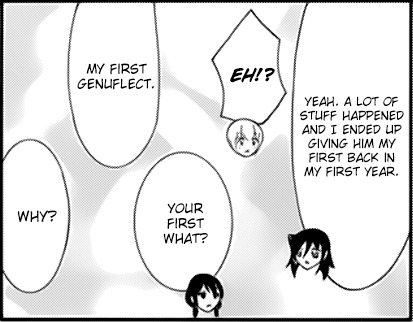
Yeah, I’m sure the original said “dogeza”, but since there isn’t really a good English equivalent for it, I think “genuflect”...is still an odd choice.
Yuri, who always has her “Tomoko’s BS” meter on high, knows that Tomoko is screwing around when she calls it her “first”. Poor Mako, a now confirmed pervert who still thinks Tomoko is so amazing, thought the girl had popped the guy’s cherry.
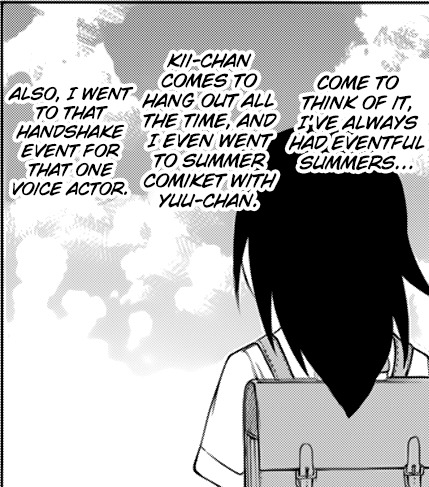
Friendly reminder that eventful summers are not necessarily pleasant summers. Though they could be with the right perspective...

So...Yuri vs. Kii-chan Death Battle when?
The most beautiful part about this ending is that there’s no second-guessing. No “maybe I won’t be lonely” or “I wonder if I’ll be lonely”. Just a very affirmative “I won’t be lonely”. Tomoko fully expects that she’ll be spending time with her friends this summer, and that confidence is more than I ever would’ve expected from Tomoko in previous years.
With summer vacation just over the horizon (don’t want to jump the gun), a medley of both happy, unhappy and delightfully awkward moments are sure to transpire. Just about the only thing Tomoko can plan is the unplanned, and I’ll be sure to get a front-row seat to watch it all.
#watamote#watamote review#chapter 163#no matter how i look at it it's you guys' fault i'm not popular!#tomoko kuroki#asuka katou#yuri tamura#hina nemoto#mako tanaka#kotomi komiyama#hatsushiba#masaki yoshida#koharu minami#emiri uchi#tomoki kuroki#kosaka#I finally get to use that tag#review
38 notes
·
View notes
Text
China and Japan's budding relationship in the time of coronavirus

Over 1,300 years ago, a grandson of the Japanese emperor sent that ancient poem to a high-ranking Chinese monk called Ganjin. It inspired him to go to Japan to spread Buddhism.Just as it did then, the poem hit home today, going viral on Weibo with more than 39,000 posts tagging the line. Even former Japanese Prime Minister Yukio Hatoyama shared it with his Twitter followers. As China battles the coronavirus outbreak that has so far killed more than 2,700 people and infected over 80,000, Japan has proved to be something of an ally. Earlier this month, China's foreign ministry spokesperson Geng Shuang lauded Japan for supporting China. By contrast, Geng accused the United States of overreacting and spreading fear by being the first to evacuate personnel from its consulate in Wuhan and imposing a travel ban on Chinese travelers.The poem signified a thawing in relations between the old enemies that can be traced back to Japanese Prime Minister Shinzo Abe's state visit to Beijing in 2018.As Tokyo and Beijing stress that the state visit of Chinese leader Xi Jinping to Japan in April will not be canceled amid the coronavirus outbreak, a renewed focus is on how the world's second and third-largest economies could deepen ties. Changing Chinese attitudesBitter territorial disputes and long-running grievances dating back to World War II have marred the Japan-China relationship for decades. During WWII, the Japanese Imperial Army was responsible for a 1937 campaign of rape, murder and looting that became known as the Nanjing Massacre, in which an estimated 300,000 people died. Japanese air strikes during the war also inflicted severe damage on Chinese civilians in Chongqing, killing an estimated 32,000 people between February 1938 and August 1943. China and Japan have often argued over how the past should be remembered. Successive Japanese governments have apologized, with some prime ministers personally expressing regret for Japan's actions in the war, but many Chinese believe Japan has not adequately acknowledged the extent of its brutal occupation of the country during WWII.Tensions flared in 2013, when the standoff over the disputed Diaoyu/Senkaku islands in the East China Sea inflamed nationalistic sentiment on both sides and impaired economic ties. Back then, 92.8% of Chinese citizens surveyed had a negative impression of Japan, according to Japanese non-profit Genron, which conducts an annual poll on Japanese and Chinese relations.By 2019, however, the number of Chinese people with "negative impressions" about Japan had almost halved to 52.8%.That follows Abe's attempts to warm relations with Chinese President Xi Jinping, with repeated invitations for talks aimed at restoring bilateral relations after the disputed island tensions. The two finally met at APEC in 2014 and shook hands in front of the world's cameras. "This is the first step towards the improvement of the bilateral relationship based on the principle of the strategic mutually-beneficial relationship," Abe said after the meeting.As political relations improved, Chinese tourists starting booking trips to Japan and forming their own, positive views on Japanese culture, according to Yasushi Kudo, president of Genron. In 2018, 8.38 million Chinese visited Japan, up sixfold from 2013, according to Genron. Chinese consumers are also watching Japanese anime on video streaming platforms like Bilibili, which has roughly 37.6 million daily users, finding information on Japan on social media rather than on domestic news sites. But while Chinese millennials with greater purchasing power are traveling more, the same can't be said of Japan, said Kudo. As the Japanese economy shrinks and millennials face issues such as the aging population and static salaries, there is less desire to explore the world, according to Kudo."You create an impression of another country by going there and making friends, but Japanese people aren't going to China that much, so they're forming their opinions based off of Japanese media reports," said Kudo.

Nevertheless, Japan is trying to make big-spending Chinese tourists feel welcome, erecting signs in Mandarin in Tokyo and broadcasting announcements in Chinese at train stations.For Shuichi Kato, whose Kyoto-based tourist organization sent 15,000 face masks to China, Hong Kong and Taiwan, visitors from these countries are a lifeline for his business. "Our region flourished as an international sight-seeing region because of our Asian friends," said Kato. By February 18, Japan's private sector had donated over 3 million masks as well as 43.96 million yuan ($6.3 million) in monetary donations. On a state level, things have been improving, too. A 'marriage of convenience'Nothing brings together two old foes like a common problem.That was the case in May 2018, when Xi and Abe held telephone talks in a historic first to discuss the denuclearization of the Korean Peninsula. A few months later, Abe became the first Japanese leader in nearly seven years to visit China when he made a state visit to Beijing.Then, China and Japan held their first forum geared to strengthen their collaborations in third-party countries such as Thailand, which has friendly diplomatic relations with both Beijing and Tokyo. By the end, both countries had inked agreements worth $18 billion. More recently, the rapprochement between China and Japan has had a lot to do with Trump's declaration of a trade war on China and Japan, according to Koichi Nakano, a political science professor at Sophia University. "Before Trump's arrival, Xi and Abe didn't have such a good relationship, now their relations are more a marriage of convenience in face of the common threat," said Nakano. But while Abe's support for China as it battles the coronavirus outbreak may have won him some mileage with Xi, it has sparked anger among his hawkish supporters at home, as Japan steps up efforts to contain its own outbreak. "The Japanese government has taken relative soft stance when it comes to blocking the flow of people from China to Japan compared to some other countries," said Nakano. "Some of Abe's supporters were angry about that as they thought he prioritized his new friendship with Xi over national security."Focusing on the positivesDespite this recent uptick in relations, fundamentally, Japan and China have rivaling visions for the future of the Asia-Pacific region and the role of China within it. Issues over territory have not gone away, but merely been placed on the back burner. "The political elites have spent the decades vilifying either side to rally their troops behind the leaders, it would be naive to think that trend would change now," Nakano said.Over the past few years, China has bolstered its naval powers in the South China Sea at a speed unmatched by any nation. In response, Japan announced in 2019 that it would allocate more resources to defend its territory from possible Chinese incursion. While Japan needs to do business with China, it's not willing to sacrifice the umbrella of US military protection, and has already built up other allegiances across the region to counter a rising China, said Jeff Kingston, a Japan expert at Temple University."For now, both sides see an advantage in dialing down tensions. Some of the permafrost has thawed but there are still deep layers of frost -- and that's not just about territory, there is also historical differences," he said.Compared to a century ago, China and Japan are now both highly modernized, globally significant economies, meaning any potential downturn in their relations could have serious ramifications globally.With a looming global economic slump and racist coronavirus-related assaults and slurs spreading faster than the outbreak, for now, China and Japan appear to be focusing on what they share in common and what benefits both parties. "The recent outbreak has been a stress-test for bilateral relations, so taking what is anxiety-inducing and turning it around was clever," said Kingston. "That poem is trying to get people to listen to the better part of themselves." Read the full article
1 note
·
View note
Text
Obituary for My Brother Rano
“I may be born as a beauty
or maybe as a beast
but I will die for truth”
(Serrano G. Sianturi)
The architect of the Sacred Rhythm music festival and the founder of Sacred Bridge Foundation, Serrano Gara Sianturi, passed away on the 26th of January 2019 in his hometown, Jakarta, Indonesia, at the age of 58, leaving a wife and two sons.
Serrano had battled an extreme pancreatic cancer known as neuroendocrine carcinoma or small cell carcinoma. At the time of his formal diagnosis in August 2018 at the National University Hospital Singapore, the cancer cells had already spread rapidly to the lungs and brain. Professor Lawrence Ho, a senior consultant there who helped in finalizing the diagnosis, mentioned to family members that Serrano had had the same cancer to which Steve Jobs, the CEO of Apple, succumbed. With the expertise, guidance and warm hospitality from a great medical team led by Dr. Chee Cheng Ean, specialist and program director in medical oncology, Serrano’s wish was granted to be moved to Jakarta to share the time remaining with his loved ones, family and friends.
“He was a true fighter and was very lucky to have a loving family by his side throughout his journey” (Dr. Chee Cheng Ean)
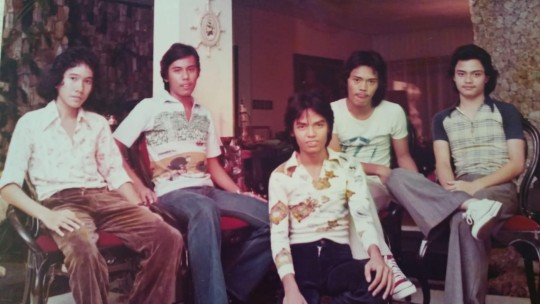
Known to many simply as Rano, he was “the Heart and Soul” (LTTW, 2019[1]) of Sacred Bridge Foundation, a not-for-profit organisation based in Jakarta which focused on bridging cultures and making the world a better place through a harmonious relationship between man and nature; to reach this ideal necessitated faith in the integration of culture, economics, and politics. Of these, culture was of utmost importance. In Rano’s own terms, as a cultural economist, he reminded us that it is time to give culture a chance where economics and politics alone have often failed to provide solutions.
Though officially founded in 1998, according to Stephen Hill, who at that time served as the Director of the Jakarta Regional Office of UNESCO, they had been collaborating for two years including censor-challenging concerts in support of international percussion music in the period shortly before the New Order Indonesian Government of President Soeharto fell in the revolution of May 1998. This was a time when freedom of expression was politically severely constrained with communities tightly controlled, the early work using cultural expression to push the boundaries of rights and protest (Hill, S., 2019).
Rano felt that this crisis period was the right time to respond by establishing a foundation that could facilitate the urgency to regain mental strengths and trust within the communities. Utilizing creativity through the Arts was a powerful medium to heal the wounds, to exercise freedom of expression and to break down boundaries in order to establish respect and mutual understanding.
In response to the Aceh Tsunami of December 2004, the Sacred Bridge and UNESCO organised a field project called ‘Rising Above the Tsunami’ whose primary aim was to heal the trauma experienced, particularly by orphaned children, utilising the intangible cultural heritage as one of the society’s self-reliant supportive systems. Acehnese traditional performers were trained to incorporate local song and dance in a disciplined way and nurture a life-long sense of arts. The impact was powerful - the children were able to smile again and their communities quite literally came alive. The film, 'Rising Above the Tsunami’ was shown to the collected Ambassadors of the World (around 190) at the UNESCO General Conference in October 2005 in Paris; many in the audience were moved to tears. The film was later shown in New York.
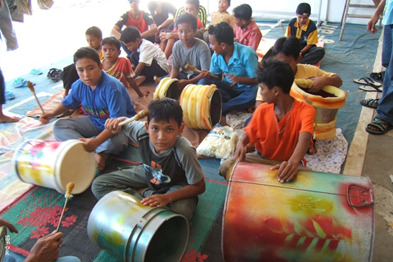
Rising Above the Tsunami in Aceh, Indonesia.
As a core element of the foundation, an International Sacred Music Concert, the ‘Sacred Rhythm’, was inaugurated as a Millennium celebration at midnight December 31, 1999 in Bali. This evolved into a series of festivals opening doors to global musical friendships and included participants Stomu Yamash’ta, Farafina, Vikku Vinayakram, Mor Thiam, I Nyoman Astita and many more.
Later finding a new home in Kyoto, Japan, the UNESCO-sponsored event utilised the creativity of dozens of renowned musicians from five continents to bring together people from different faiths, nationalities and walks of life. By re-uniting humanity and nature, and upholding culture, the rising sun of the twenty-first century was embraced. Music then became a focal point of cultural development more than twenty years after the World Conference on Cultural Policies. Rano, as the main organiser and inspiration, together with Stephen Hill, Philippe Delanghe and Stomu Yamash’ta believed it was time to make a statement.

Sacred Rhythm: The Millennial Percussion for Unison in Bali, Indonesia (1999-2000).

Sacred Rhythm in Kyoto, Japan
“Collaboratively, they wanted to show to the world - on behalf of the United Nations - that if we are to reflect on the next one thousand years, this must be in spiritual and human terms, not commercial” (Hill et all, p. vi, preface Kyoto Manifesto, 2018)
“Use Cultural Currencies for equality and understanding” (Serrano G. Sianturi)

Rano spent almost a quarter of his life in the United States of America pursuing his education. A Bachelor degree in Architecture Engineering from Milwaukee School of Engineering in 1981 was followed two years later with a Masters degree in Earthquake Engineering at MIT. Returning to Indonesia, he joined the university Civil Engineering faculty, subsequently accepting the invitation to work with the then Directorate of Public Buildings of the Ministry of Public works. During this time, he trained and supervised the research of many Indonesian volcanologists. In 1988, he resigned from both organizations and returned to MIT to pursue a completely different course of education - gaining a post-graduate economics degree specializing in Cultural Economics.
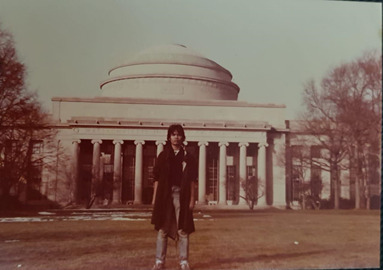
Upon his return to Indonesia in 1991, Rano immediately established an economic and marketing advisory firm and served major multinational companies including Citibank, NTT, Club Med, Price Waterhouse, WWF, Jardine, Allied Queensland Coalfield, Fuji Bank International, as well as national companies such as the Jakarta Stock Exchange, Elnusa, and Telkom.
After seven years practicing as an economic consultant, he decided to pursue his long-time interest in cultural economics. He then established the Sacred Bridge where the foundation focused on action research works and model making covering five domains: Cultural Education for the Young, Cultivation of Roots Arts, Intercultural Dialogue, Capacity Building, and New Media. Since his involvement in the Foundation, Rano conducted research and field programs in Indonesia that included Aceh, Nias, Jakarta, West Java, Borobudur, East Kalimantan, South Sulawesi, Bali, and West Papua. Sacred Bridge itself was the first UNESCO counterpart in the field of culture. In addition to the field works, Serrano managed to consult and write for international journals as well as give academic lectures at many well-respected universities in the US, UK, and Japan, with focus on cultural economics.
His inspirations, achievements and contributions for Indonesia and beyond are immeasurable but he never worked for personal recognition. He was critical of the narrow and seemingly opportunistic viewpoints of many Indonesian academics and institutions in various fields and challenged them to aspire to a higher level of understanding and interpretation for the betterment of the country and humanity. While battling the cancer, Rano mentioned in several occasions that his unfinished book title ‘Economics for Humanity’ became the least important for many reasons, but one reason that stood out as a reflection of his faith in the young generations to come, he said their books would be far more important than his.
On many occasions, while reading local newspapers, Rano said to his eldest son, Boo-boo Sianturi, now the chairman of the foundation, “Hey, they’re my ideas, that’s my writing, completely plagiarized”. He then continued, “Oh well, that’s okay, as long as they learn things the right way, understanding the importance of fundamentals…and so on, let the people learn, let the nation learn”. Rano stressed the importance of understanding contexts and fundamentals challenging their credibility on ethical grounds. In his view, the most respected profession is teaching; not only are adequate knowledge and experience required but teaching also comes with a set of responsibilities.
“Serrano Sianturi, he was my best friend and hero of his mother country”, Stomu Yamash’ta (founding member of Sacred Bridge foundation)
In 2013, Rano brought together Stomu Yamash’ta, Stephen Hill and I Nyoman Astita in Bali where they visited villages, exploring a possible way of developing the Cultural Centre which Rano was planning as a Sacred Bridge Initiative. What transpired instead was the development of a very fruitful partnership of Rano, Stomu and Stephen with the just established ‘Centre for the Creative Economy’ at Doshisha University, Kyoto, and its Director, Tadashi Yagi. Together, they trawled the world for four years through Annual International Symposia in Kyoto in search of the best participants for their planned book which sought to re-ground global economics in our core humanity and spirituality. Prior to every Symposium Stomu produced his ‘On-Zen’ performance bringing Buddhist and Shinto priests together in combined ritual in Kyoto’s Daitokuji Buddhist Temple - in a ceremony of peace and cross-religious care - the first time in 800 years that Buddhism and Shinto had shared in such a way. Rano had brought Stephen and Stomu together in the first place – via the meeting in Bali, and spoke at the first International Symposium in June 2014, but unfortunately, after that, was too ill to participate any more.
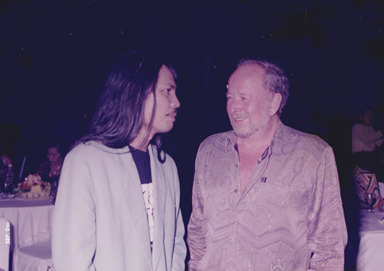
Rano with Stephen Hill

Rano with Stomu Yamash’ta.
The book “The Kyoto Manifesto for Global Economics - The Platform of Community, Humanity and Spirituality” resulted from this collaboration and was published internationally last year by Springer. Under Stomu’s inspiration, Stephen designed the structure of the book as a ‘Symphony’, and then elaborated it further as a ‘Polyphony’, i.e. bringing two or more separate themes together into an overall harmony.
“We all, however, owe Rano an enormous debt of gratitude for his humanity, vision, commitment, generosity, and inspiration. He is both our own dear friend and a friend to humanity as a whole”. (Hill et al, Kyoto Manifesto, 2018)
During the last few months of Rano’s life, he believed that the Sacred Bridge needed to continue and was convinced that the younger generations were equipped and ready to lead the foundation into the second decade of the 21st century. On January 13, 2019, 13 days before Rano’s departure, the Sacred Bridge was marked by a “Reborn” gathering at their headquarters in Jakarta. The word “Reborn” itself was inspired by the Sacred Rhythm II (Reborn Unison) concert that took place in Bali last August 2018.

Sacred Rhythm: Reborn Unison in Bali, Indonesia. (2018)
Now, almost twenty years after the first Sacred Rhythm, Rano believed that it was time to elaborate the statement. Reborn Unison emphasises the need to work together for culture to become both driver and enabler of human development, sustainable development, or the upholding of continuous and inclusive improvement of human well-being. It is this old way that is cherished by Sacred Rhythm II (Reborn Unison), paving the ground for a new generation of artists, scientists, and spiritual activists to come together, shaping and spreading the message of culture through their world-wide networks.
Bintang Perkasa, who is now the programme director, concludes Rano’s view that in the eyes of Sacred Bridge, “reborn” is not merely rebirth, but also rethinking and revisiting its fundamental values based on guidance of the past and present life to re-focus (including re-evaluate) the foundation towards the future. He further emphasizes Rano’s own words that “changes can only happen on the ground,” capturing the very spirit of Sacred Bridge “Reborn”. This will be manifested in its plan to return to fieldwork, the change initiated and agreed by Rano himself with the acknowledgment and consent of the active founders.
Rano, Rest in the Peace You Deserve. The Peace of Love – the guiding light of your life!
Stephen Hill
26thJanuary 2019
Sources:
Hill et al, Kyoto Manifesto, 2018
Email exchanges (Boo-boo and Stephen), 2018-2019
Email exchanges (Boo-boo and Dr. Chee), 2019-03-02
LTTW, 2019 (http://www.listentotheworld.net/human-voices/serrano-g-sianturi-the-heart-and-soul-of-sacred-bridge/)
Sacred Bridge Web, 2019 (http://www.sacredbridge.org/the-bridge/history/)
[1] LTTW, Obituary SGS news, 2019 (http://www.listentotheworld.net/human-voices/serrano-g-sianturi-the-heart-and-soul-of-sacred-bridge/)
1 note
·
View note
Text

Bye, The Millennials Kyoto! 👋
Thanks for being so great! Sorry you have such a silly name!
See you again, some other time!
2 notes
·
View notes